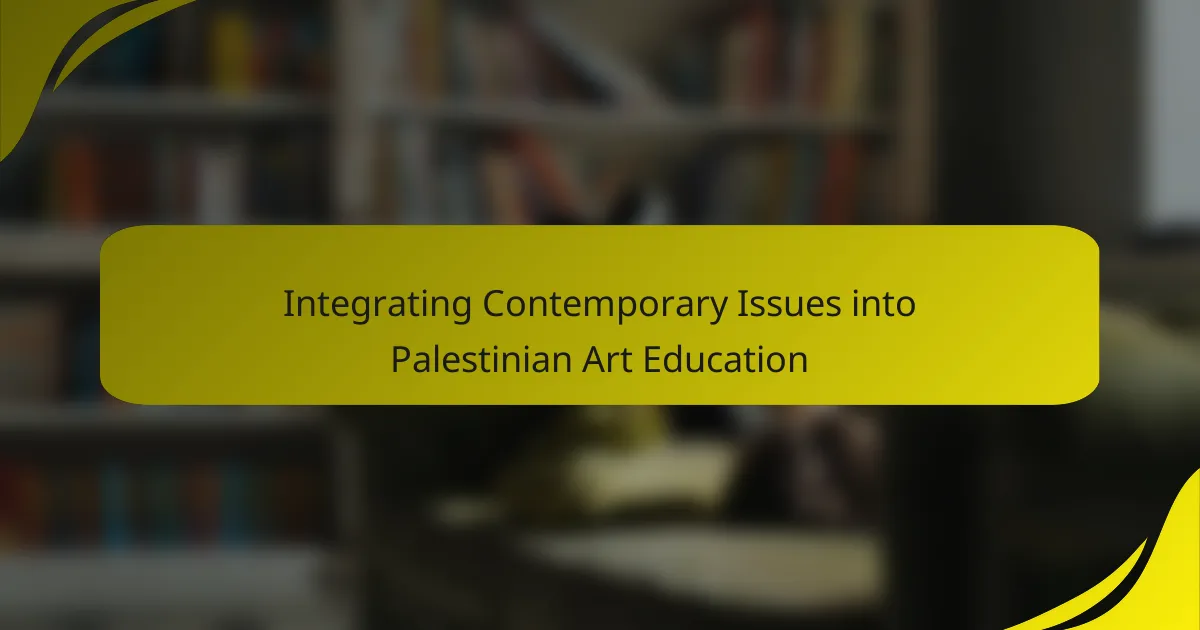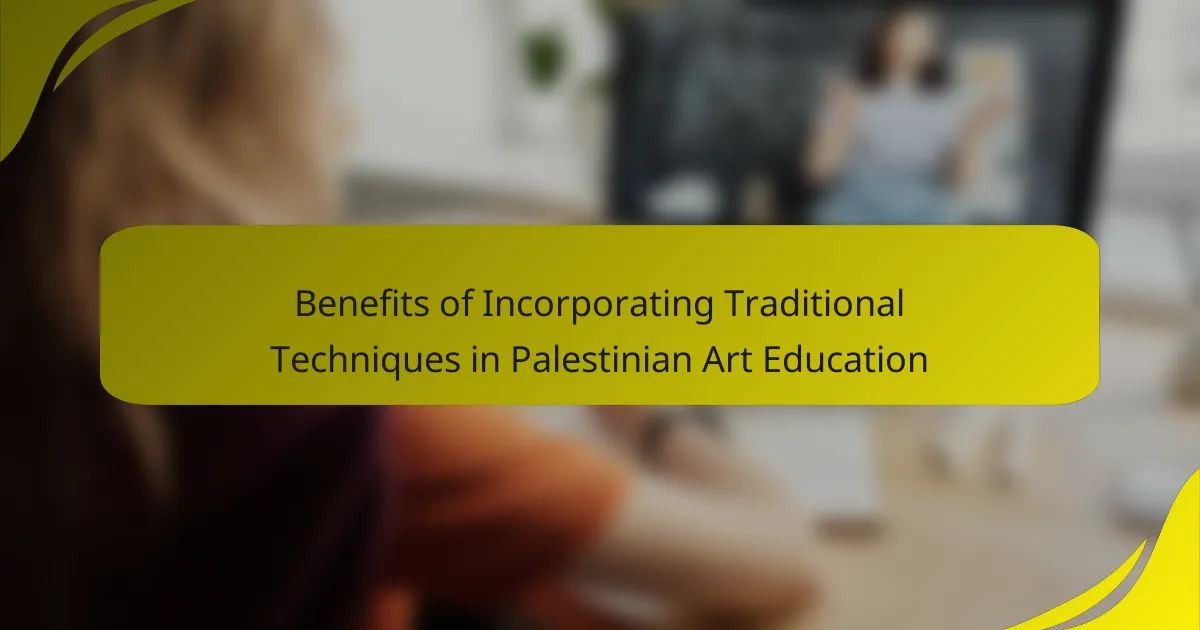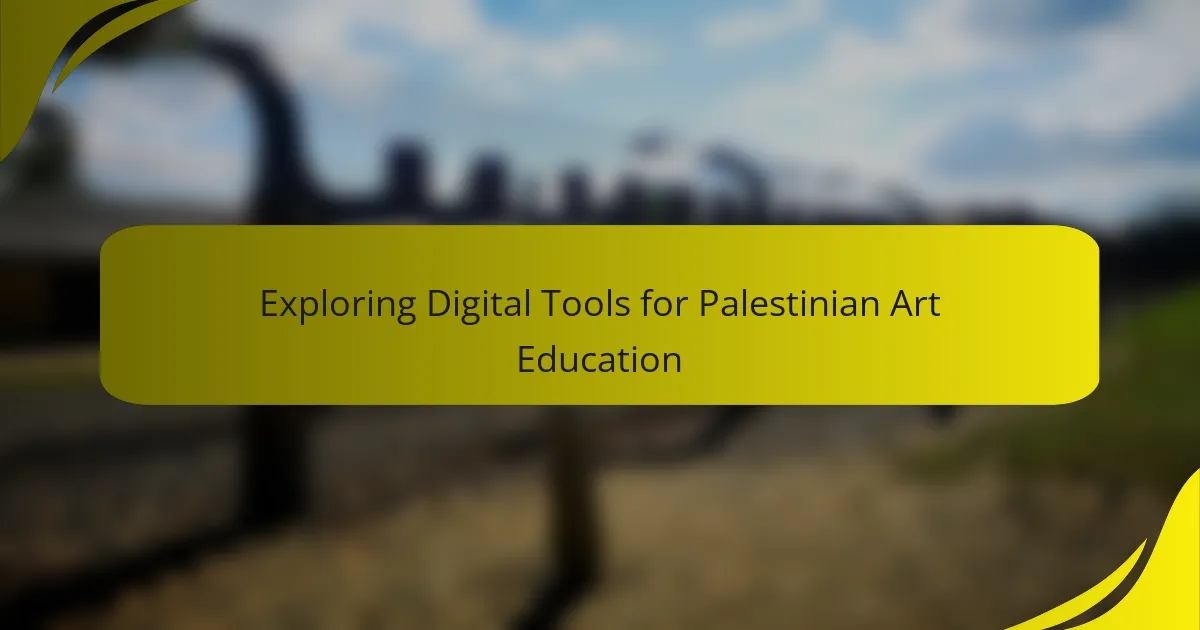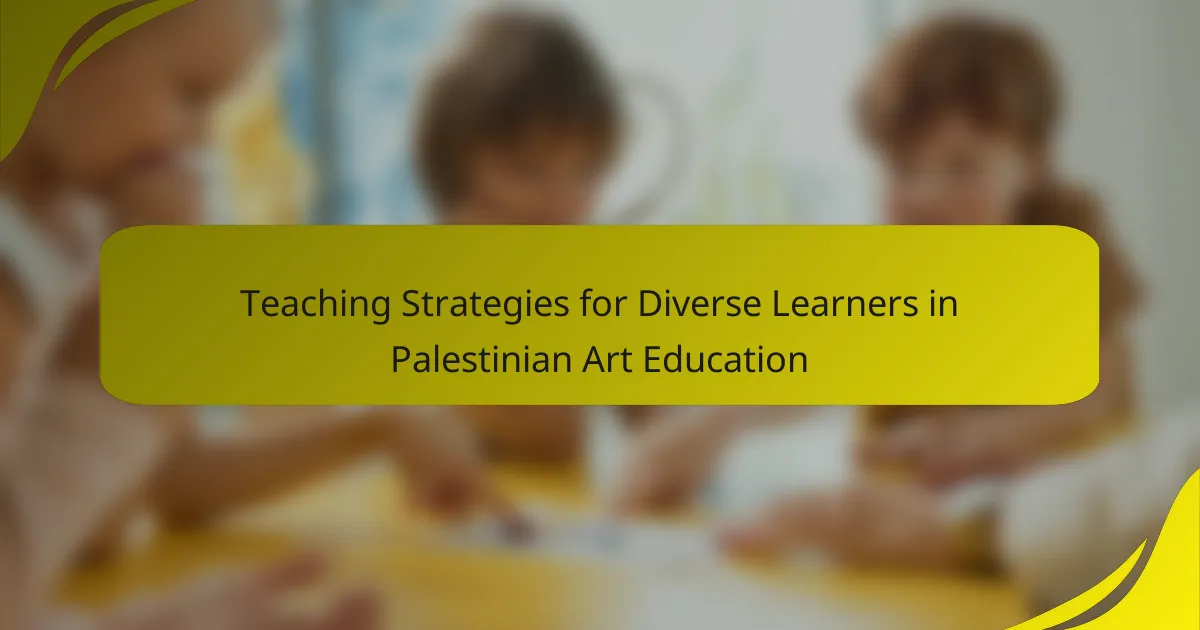Cultural heritage is a fundamental aspect of Palestinian art education, shaping artistic expression and identity. This article examines how traditional motifs, narratives, and techniques are integrated into the curriculum, enriching students’ understanding of their history and fostering pride in their cultural identity. It highlights key components such as traditional art forms, community involvement, and the challenges faced in preserving cultural heritage amid political instability and limited resources. The discussion emphasizes the importance of these elements in enhancing creativity and critical thinking skills while ensuring the transmission of Palestinian artistic practices to future generations.
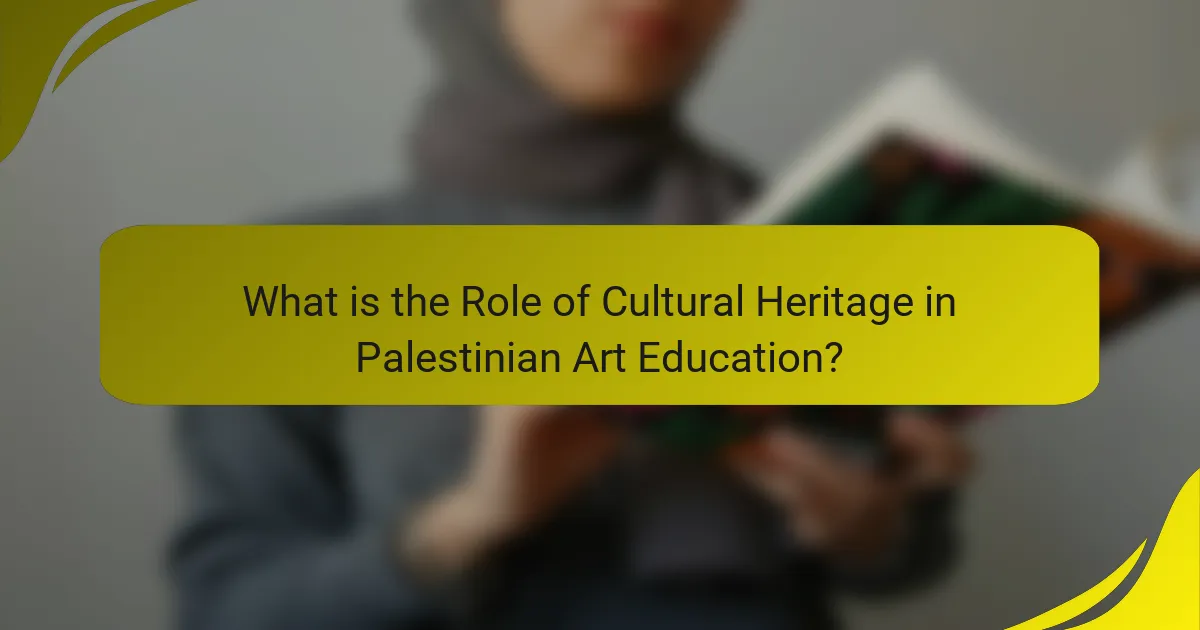
What is the Role of Cultural Heritage in Palestinian Art Education?
Cultural heritage plays a vital role in Palestinian art education. It serves as a foundation for artistic expression and identity. The integration of traditional motifs and narratives enriches the curriculum. Students learn about their history and cultural significance through art. This connection fosters a sense of belonging and pride. Moreover, it encourages the preservation of unique artistic practices. Research indicates that cultural heritage enhances creativity and critical thinking skills. Engaging with heritage fosters a deeper understanding of contemporary issues.
How does cultural heritage influence artistic expression in Palestine?
Cultural heritage significantly influences artistic expression in Palestine. It shapes the themes, styles, and techniques used by artists. Traditional motifs, historical narratives, and cultural symbols are frequently incorporated into artworks. These elements reflect the identity and struggles of the Palestinian people. The use of local materials and methods connects artists to their heritage. Festivals and community events promote the sharing of these artistic expressions. Historical events, such as the Nakba, inspire many contemporary works. Thus, cultural heritage serves as a foundation for both personal and collective expression in Palestinian art.
What specific elements of Palestinian cultural heritage are reflected in art education?
Palestinian cultural heritage is reflected in art education through traditional motifs, storytelling, and historical narratives. Traditional motifs include patterns and designs found in Palestinian embroidery and ceramics. These motifs serve as visual representations of identity and cultural pride. Storytelling is another element, often conveyed through visual arts, that preserves oral histories and folklore. Historical narratives are integrated into art education, highlighting significant events and figures in Palestinian history. This approach fosters a sense of belonging and awareness among students. Art education thus becomes a medium for cultural expression and preservation.
How do traditional practices shape contemporary Palestinian art?
Traditional practices significantly influence contemporary Palestinian art. These practices include folk art, embroidery, and storytelling. Artists incorporate traditional motifs and techniques into modern works. This fusion creates a dialogue between past and present. For example, the use of vibrant colors and patterns reflects cultural heritage. Artists like Nabil Anani blend traditional themes with contemporary styles. This approach preserves cultural identity while addressing modern issues. The integration of these elements fosters a unique artistic expression. Overall, traditional practices serve as a foundation for innovation in Palestinian art.
Why is cultural heritage important for identity in Palestinian art education?
Cultural heritage is crucial for identity in Palestinian art education as it shapes the artistic expression and understanding of Palestinian students. It provides a framework for them to explore their history, traditions, and values through art. This connection to heritage fosters a sense of belonging and pride among students. Art education rooted in cultural heritage allows for the preservation of Palestinian narratives and experiences. It encourages students to engage with their identity creatively and critically. Furthermore, studies show that art reflecting cultural heritage enhances emotional and social development. This integration of heritage in education supports the continuity of Palestinian culture for future generations.
How does cultural heritage contribute to the formation of Palestinian identity?
Cultural heritage significantly shapes Palestinian identity by preserving historical narratives and traditions. It encompasses language, music, dance, and art, which reflect the community’s collective memory. These cultural expressions foster a sense of belonging among Palestinians. They connect individuals to their history and shared experiences. The traditional practices, such as embroidery and folklore, reinforce cultural continuity. Additionally, cultural heritage serves as a form of resistance against displacement and erasure. Events like cultural festivals celebrate and promote Palestinian identity globally. Through education, cultural heritage is transmitted to younger generations, ensuring its survival and relevance.
What role does art play in preserving cultural heritage among Palestinian youth?
Art serves as a vital tool for preserving cultural heritage among Palestinian youth. It enables them to express their identity and connect with their history. Through various forms of art, such as painting, music, and dance, young Palestinians convey their narratives and experiences. Art education fosters a sense of pride in their heritage. It encourages exploration of traditional themes and motifs. This engagement helps keep cultural practices alive. Additionally, community art projects often focus on historical events and local stories. Such initiatives strengthen communal bonds and promote cultural continuity. Overall, art plays a crucial role in empowering Palestinian youth to maintain and celebrate their cultural heritage.
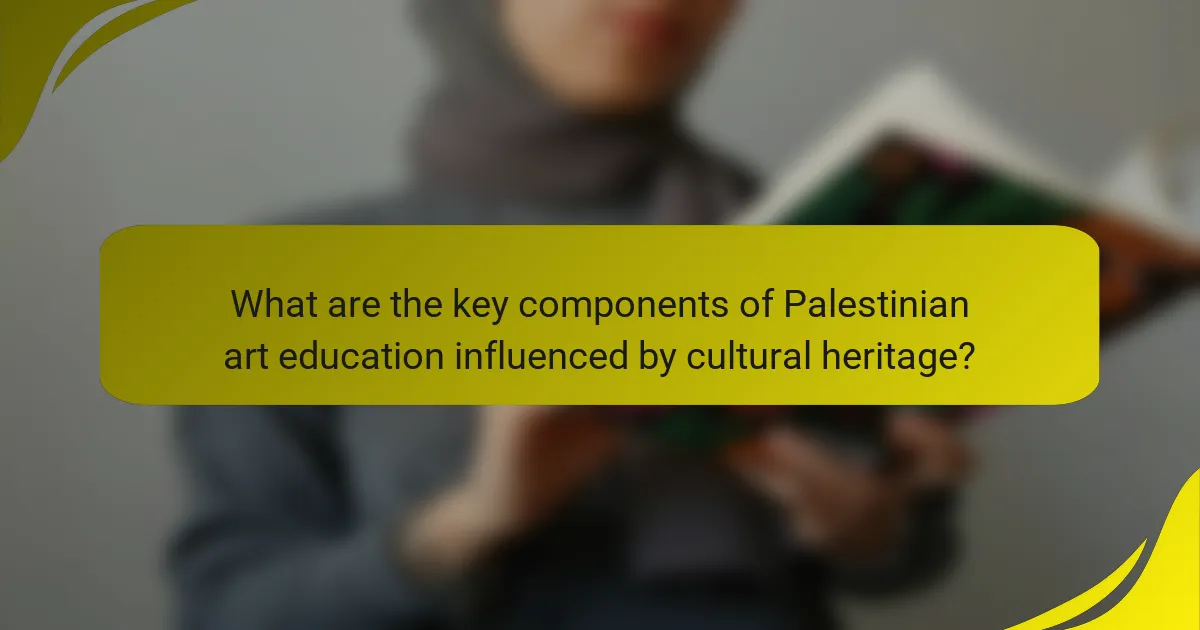
What are the key components of Palestinian art education influenced by cultural heritage?
The key components of Palestinian art education influenced by cultural heritage include traditional techniques, cultural narratives, and community involvement. Traditional techniques involve the use of age-old methods like embroidery and pottery. Cultural narratives express the history, struggles, and identity of the Palestinian people through various art forms. Community involvement emphasizes collaborative projects that engage local artists and students in cultural preservation. These components reflect the rich heritage and identity of Palestine, fostering a sense of belonging and continuity. The integration of these elements enhances the educational experience, making art a vital part of cultural expression.
What types of artistic practices are emphasized in Palestinian art education?
Palestinian art education emphasizes various artistic practices, including traditional crafts, visual arts, and performance arts. Traditional crafts often involve techniques such as embroidery and pottery, reflecting cultural heritage. Visual arts include painting, drawing, and sculpture, which express social and political themes. Performance arts encompass theater and dance, highlighting storytelling and community engagement. These practices aim to foster cultural identity and resilience among students. They also serve as a means of documenting and preserving Palestinian history and experiences.
How are traditional crafts integrated into modern art curricula?
Traditional crafts are integrated into modern art curricula by incorporating hands-on workshops and projects. These activities allow students to explore cultural heritage through practical experience. Instructors often emphasize the historical significance of these crafts. They connect traditional techniques with contemporary artistic practices. This integration fosters an appreciation for cultural identity. Research shows that students benefit from learning traditional methods alongside modern concepts. This approach enhances creativity and critical thinking. It also promotes cultural preservation in art education.
What significance do local materials have in Palestinian art education?
Local materials are significant in Palestinian art education as they embody cultural identity and heritage. Using these materials connects students to their history and environment. These resources foster creativity by encouraging unique artistic expressions. They also promote sustainability by utilizing locally sourced items. The engagement with local materials enhances community ties and supports local economies. Moreover, this practice preserves traditional techniques and knowledge. Research shows that incorporating local materials enriches the educational experience and deepens cultural understanding.
How do educators incorporate cultural heritage into their teaching methods?
Educators incorporate cultural heritage into their teaching methods by integrating local history and traditions into curricula. They use art projects that reflect cultural symbols and narratives. This approach fosters a deeper understanding of students’ identities. Educators also invite community members to share stories and practices. Such interactions enhance the relevance of lessons. Additionally, they utilize traditional art forms as teaching tools. This method promotes appreciation for cultural diversity. Research shows that culturally relevant education improves student engagement and learning outcomes.
What pedagogical approaches are most effective in teaching Palestinian art?
Experiential learning and culturally responsive teaching are the most effective pedagogical approaches in teaching Palestinian art. Experiential learning immerses students in hands-on activities that connect them with their cultural heritage. This method fosters a deeper understanding of artistic techniques and historical contexts. Culturally responsive teaching recognizes the unique cultural backgrounds of Palestinian students. It incorporates their experiences into the curriculum, making the art lessons relevant and engaging.
Research shows that students learn better when they see their culture reflected in the curriculum. A study by Al-Azzeh (2019) highlights the importance of integrating local traditions and narratives in art education. This approach not only enhances artistic skills but also strengthens cultural identity among students. Thus, combining experiential learning with culturally responsive teaching creates an effective framework for teaching Palestinian art.
How do educators engage students with their cultural heritage through art?
Educators engage students with their cultural heritage through art by incorporating traditional themes and techniques into the curriculum. They utilize local art forms, such as embroidery and pottery, to connect students with their history. Workshops and hands-on projects allow students to create art that reflects their cultural identity. Educators also organize field trips to museums and heritage sites, fostering a deeper understanding of cultural significance. Collaborative projects with community artists help students learn directly from cultural practitioners. Integrating storytelling into art lessons emphasizes the narratives behind cultural artifacts. This approach not only preserves heritage but also encourages critical thinking about identity. Research shows that such engagement enhances students’ self-esteem and cultural pride.
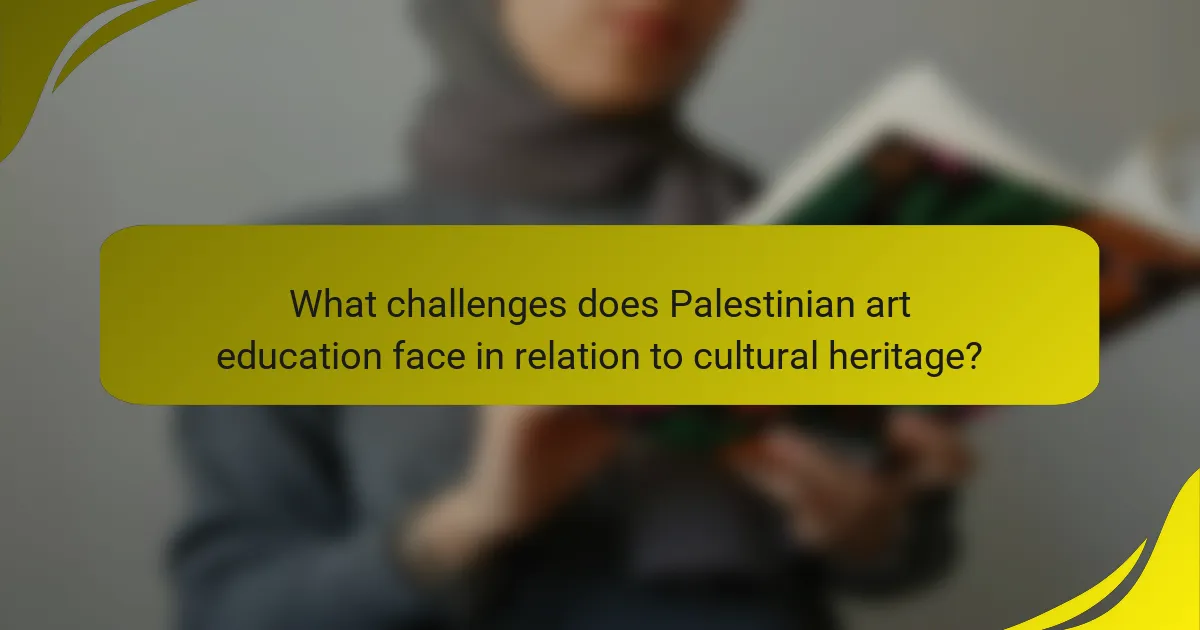
What challenges does Palestinian art education face in relation to cultural heritage?
Palestinian art education faces significant challenges in preserving cultural heritage. Limited resources hinder access to quality materials and training. Political instability affects the continuity of educational programs. Restrictions on movement impede collaboration with regional and international artists. The lack of formal recognition for Palestinian cultural expressions diminishes their visibility. Additionally, ongoing conflict often disrupts traditional art practices. These factors collectively threaten the transmission of cultural heritage to future generations.
How do political and social factors impact art education in Palestine?
Political and social factors significantly impact art education in Palestine. The ongoing Israeli-Palestinian conflict restricts access to resources and opportunities for students. Art programs often face funding shortages due to political instability. Additionally, social factors such as cultural identity shape the curriculum in art education. Palestinian heritage is emphasized in art to foster national identity. Restrictions on movement limit artists’ exposure to global influences. Furthermore, societal attitudes towards art can either support or hinder creative expression. These elements collectively influence the quality and scope of art education in the region.
What barriers do educators encounter when teaching about cultural heritage?
Educators encounter several barriers when teaching about cultural heritage. Limited resources hinder effective lesson planning and material availability. Cultural sensitivity issues may arise, complicating discussions about heritage. Diverse student backgrounds can lead to varying levels of interest and understanding. Political and social tensions may affect the teaching environment. Additionally, a lack of professional development opportunities limits educators’ preparedness. Research by the National Endowment for the Humanities highlights these challenges in cultural education.
How can these challenges be addressed to enhance art education?
Integrating cultural heritage into art education can address challenges effectively. This approach fosters a sense of identity among students. It encourages the exploration of local history and traditions. Incorporating local artists and their works enhances relevance. Curriculum development should include diverse cultural narratives. Community involvement in educational programs can strengthen connections. Providing resources for teachers to understand cultural contexts is essential. Research shows that culturally relevant pedagogy improves student engagement and achievement.
What role do community initiatives play in promoting cultural heritage in art education?
Community initiatives play a vital role in promoting cultural heritage in art education. They create platforms for local artists and educators to collaborate. These initiatives often involve workshops, exhibitions, and cultural events. Such activities engage the community in preserving and sharing their heritage. They also provide students with hands-on experiences that connect them to their culture. For example, initiatives may focus on traditional crafts or local storytelling. This direct involvement fosters a deeper appreciation for cultural identity. Studies show that community engagement enhances students’ understanding of their heritage.
How do local organizations support art education in relation to cultural heritage?
Local organizations support art education by integrating cultural heritage into their programs. They offer workshops that focus on traditional art forms. These workshops often include local artists who share their expertise. Organizations also provide resources that highlight cultural history. This helps students understand the significance of their heritage. Collaborations with schools enhance curriculum related to local culture. Events like exhibitions showcase student work influenced by cultural themes. Research shows that this approach fosters a sense of identity and belonging among students.
What successful examples exist of community engagement in Palestinian art education?
Successful examples of community engagement in Palestinian art education include initiatives like the “Art for Change” program. This program fosters collaboration between artists and local communities. It emphasizes the importance of cultural heritage in shaping artistic expression.
Another example is the “Palestinian Art Academy,” which organizes workshops and exhibitions. These events encourage participation from diverse community members. They focus on traditional Palestinian art forms and contemporary practices.
The “Youth Cultural Forum” also plays a significant role. It provides a platform for young artists to share their work. The forum promotes dialogue on cultural identity and social issues.
These initiatives demonstrate how art education can unite communities. They highlight the significance of preserving and promoting Palestinian cultural heritage.
What best practices can enhance the role of cultural heritage in Palestinian art education?
Integrating cultural heritage into Palestinian art education can be enhanced through several best practices. First, incorporating traditional art forms into the curriculum is essential. This includes teaching techniques such as embroidery, pottery, and calligraphy, which are significant to Palestinian culture. Second, fostering collaborations with local artists can provide students with real-world insights. Engaging artists who specialize in cultural themes can inspire students and deepen their understanding.
Third, organizing community art projects can reinforce cultural identity. These projects allow students to create works that reflect their heritage while involving the community. Fourth, utilizing local history and narratives in art discussions can enrich students’ perspectives. This approach helps students connect their artistic expressions to their cultural stories.
Fifth, creating a resource library that includes books, documentaries, and digital content about Palestinian art and culture can support learning. Access to diverse materials enhances students’ knowledge and appreciation of their heritage. Lastly, promoting exhibitions of student artwork that focus on cultural themes can showcase their understanding and pride in their heritage. These practices collectively strengthen the role of cultural heritage in Palestinian art education.
How can collaboration between artists and educators improve art education?
Collaboration between artists and educators can enhance art education by integrating practical experience with theoretical knowledge. Artists bring real-world insights and contemporary practices into the classroom. This exposure allows students to engage with art in a meaningful way. Educators provide a structured environment for students to explore these insights. Together, they can develop curricula that reflect cultural heritage and community values. This approach fosters creativity and critical thinking among students. Research shows that students benefit from hands-on learning experiences. For instance, a study by the National Art Education Association highlights improved student engagement through artist-led workshops.
What strategies can be implemented to better integrate cultural heritage into curricula?
Integrating cultural heritage into curricula can be achieved through several strategies. One effective approach is incorporating local artists and cultural practitioners into the classroom. This allows students to learn directly from those who embody and express their cultural heritage. Another strategy is to include project-based learning that focuses on local history and traditions. This method encourages students to engage with their cultural context actively.
Additionally, developing partnerships with cultural institutions can enhance resource availability. Schools can collaborate with museums and cultural centers to provide students with hands-on experiences. Implementing interdisciplinary lessons that connect art, history, and cultural studies can also enrich the learning experience. For instance, lessons can explore the significance of traditional Palestinian art forms.
Furthermore, utilizing technology can facilitate access to digital archives and resources related to cultural heritage. This can broaden students’ understanding and appreciation of their cultural background. Finally, teacher training programs should emphasize the importance of cultural heritage in education. Educators equipped with this knowledge can effectively convey its relevance to students.
The main entity of the article is cultural heritage in the context of Palestinian art education. The article explores how cultural heritage serves as a foundation for artistic expression and identity among Palestinian students, emphasizing the integration of traditional motifs, historical narratives, and community involvement in art education. It highlights the significance of local materials and traditional practices in shaping contemporary Palestinian art while addressing the challenges faced in preserving cultural heritage amid political and social factors. The article also discusses effective pedagogical approaches and community initiatives that enhance the role of cultural heritage in art education, ultimately fostering a sense of belonging and pride among students.
